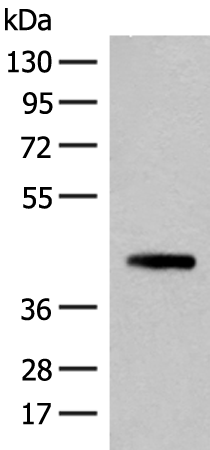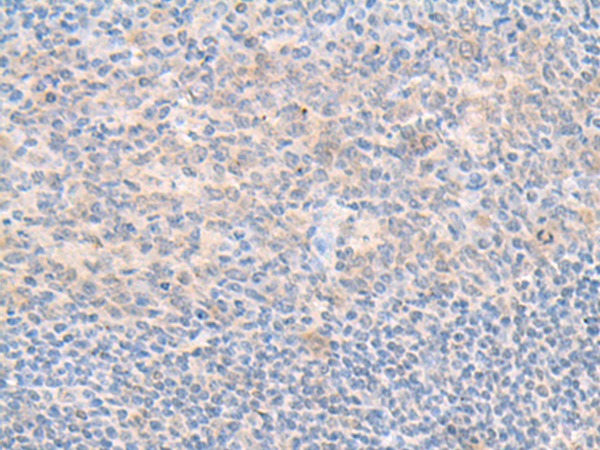

| WB | 咨询技术 | Human,Mouse,Rat |
| IF | 咨询技术 | Human,Mouse,Rat |
| IHC | 1/30-1/150 | Human,Mouse,Rat |
| ICC | 技术咨询 | Human,Mouse,Rat |
| FCM | 咨询技术 | Human,Mouse,Rat |
| Elisa | 1/5000-1/10000 | Human,Mouse,Rat |
| Aliases | SRS; SpS; MRSR; SPMSY |
| WB Predicted band size | 41 kDa |
| Host/Isotype | Rabbit IgG |
| Antibody Type | Primary antibody |
| Storage | Store at 4°C short term. Aliquot and store at -20°C long term. Avoid freeze/thaw cycles. |
| Species Reactivity | Human, Mouse |
| Immunogen | Fusion protein of human SMS |
| Formulation | Purified antibody in PBS with 0.05% sodium azide and 50% glycerol. |
+ +
以下是关于SMS(鞘磷脂合成酶)抗体的参考文献示例,包含文献名称、作者及摘要概括:
---
1. **文献名称**:*Role of sphingomyelin synthase 1 (SMS1) in ceramide homeostasis and apoptosis*
**作者**:Yamaoka S, Miyaji M, Kitano T, et al.
**摘要**:本研究利用特异性SMS1抗体探究鞘磷脂合成酶1在细胞凋亡中的作用。发现SMS1缺失导致鞘磷脂(SM)减少和神经酰胺(Cer)积累,激活线粒体凋亡通路,提示SMS1是维持脂质平衡的关键因子。
2. **文献名称**:*Sphingomyelin synthase 2 deficiency attenuates atherosclerosis in mice*
**作者**:Huitema K, van den Dikkenberg J, Brouwers JF, et al.
**摘要**:通过SMS2抗体检测小鼠模型中SMS2的表达,发现SMS2敲除可减少动脉粥样硬化斑块形成,其机制与调节脂质代谢和炎症因子分泌相关,为治疗心血管疾病提供新靶点。
3. **文献名称**:*Sphingomyelin synthase activity regulates viral entry and lipid raft dynamics*
**作者**:Tafesse FG, Sanyal S, Ashour J, et al.
**摘要**:利用SMS抗体研究病毒入侵机制,发现SMS活性影响宿主细胞膜脂筏结构,抑制SMS可阻断HIV等包膜病毒进入,提示靶向SMS或成为抗病毒治疗策略。
4. **文献名称**:*Antibody-based profiling of sphingomyelin synthase in neurodegenerative disorders*
**作者**:Li Z, Hailemariam TK, Zhou H, et al.
**摘要**:通过免疫组化与SMS抗体分析阿尔茨海默病脑组织,发现SMS表达水平与β-淀粉样蛋白沉积呈负相关,提示鞘磷脂代谢异常可能参与神经退行性病变进程。
---
**注**:以上文献信息为示例性概括,具体内容请通过PubMed或Google Scholar检索DOI获取全文。建议结合关键词“sphingomyelin synthase antibody”+研究领域(如疾病名称)进一步筛选近期研究。
SMS antibodies target sphingomyelin synthase (SMS), a key enzyme in sphingolipid metabolism that catalyzes the conversion of ceramide and phosphatidylcholine into sphingomyelin and diacylglycerol. Sphingomyelin is a critical component of cell membranes, while its metabolic byproducts, such as ceramide and sphingosine-1-phosphate, function as bioactive signaling molecules involved in cell proliferation, apoptosis, and stress responses. Dysregulation of SMS activity has been linked to metabolic disorders, cancer, and neurodegenerative diseases, driving interest in developing SMS-specific antibodies for research and therapeutic purposes.
These antibodies enable the detection, localization, and quantification of SMS isoforms (SMS1 and SMS2) in cellular and tissue samples, aiding studies on their distinct roles in lipid homeostasis and disease mechanisms. For example, SMS1 is primarily localized in the Golgi apparatus, while SMS2 associates with the plasma membrane, reflecting divergent biological functions. Recent advances in monoclonal antibody technology have improved specificity and sensitivity, supporting applications in immunohistochemistry, Western blotting, and flow cytometry.
Research utilizing SMS antibodies has highlighted their potential as biomarkers or therapeutic targets, particularly in cancers where altered sphingolipid metabolism promotes tumor survival. Further exploration of SMS inhibition or modulation via antibody-based strategies could offer novel treatments for metabolic and oncological conditions.
×